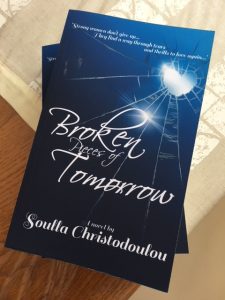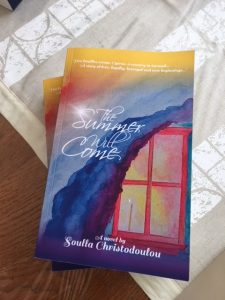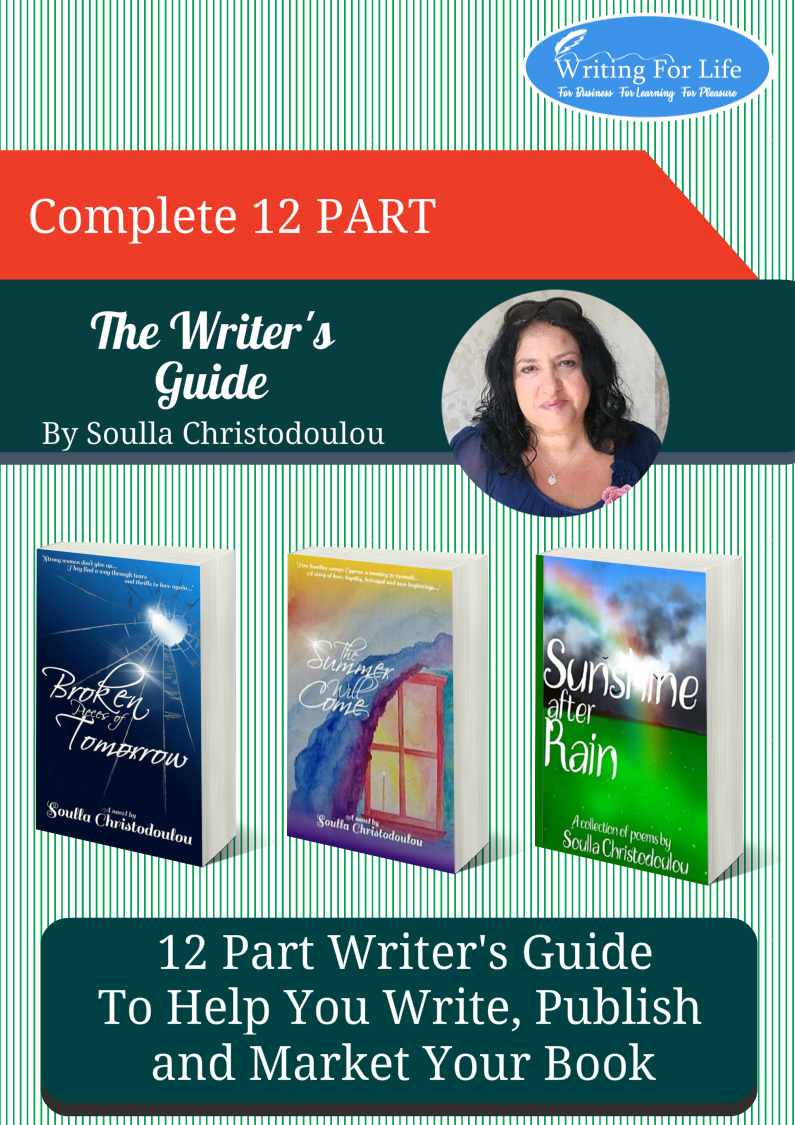Welcome everyone! I am delighted Mya Glenister agreed to do this featured blog post! As a former teacher of Business Studies and Pastoral Leader in a local secondary school, I am a huge advocate of giving young people opportunities to learn, develop, enhance their skills and build resilience and confidence too.
After launching a competition via Instagram for artists to come up for book cover ideas for my two novels, I chose Mya Glenister’s design out of six proposed designs sent to me as well as an original painting on canvas by another Athens-based student, Alexandros Sainidis.
This is her experience in her own words and I will be forever grateful to her for her dedication, mature approach and tireless edits to the final designs I used for Broken Pieces of Tomorrow and The Summer Will Come. This is Mya’s story:
Hi, my name is Mya Glenister and I’m a 15-year-old from the United Kingdom. I designed the cover for Broken Pieces of Tomorrow and formatted the cover for The Summer Will Come. I met Soulla on Instagram after she had seen some of my work, and she messaged me and asked me if I wanted to take part in a competition to design her book cover. It was quite exciting for somebody to suggest something like this – I was, and still am, a very small artist and nobody had really noticed me or recognised my art before. Being selected and taking up an opportunity like this was both exciting and scary, but it was fun and I recognised it as being potentially important for my future too. I should also mention that Soulla contacted my mum and Okayed our working together as I am still a minor.


6 things I have learned through designing book covers (plus some tips)
1. Art block is incredibly frustrating
Art block is when an artist has absolutely no ideas or inspiration. I think that designing a book cover is easier said than done. It is incredibly frustrating when you can’t think of anything to put on the cover, particularly when there’s a deadline. I’ve had art block plenty of times before, but when there’s a deadline it gets a lot worse. To combat it, Soulla suggested that I use Google images to search words from the title of the book, and her summary of the story, to source a bank of images and ideas. Well, it worked, and that’s where I got the idea of the crack for the cover of Broken Pieces of Tomorrow. The heart comes from the romance part of the story.
2. Decisions
Deciding the fonts and colours was really difficult. I had to research a lot of things to set the mood of the story. With Broken Pieces of Tomorrow, I created the entire cover, so I had to research both fonts and a colour scheme. The light and dark blue background can connote the sadness that Georgia goes through as well as her strength as she goes on her journey to new beginnings. The white of the text and in the centre of the heart represents purity, hope and starting over. The use of these colours sets the tone of the book before the reader has even started reading it. Fonts can also draw readers in and set the tone of the book. Cursive and script fonts, like the ones I used on the Broken Pieces of Tomorrow cover, look very feminine and quite mature, which signifies that the book is a women’s adult fiction. Also, be careful which fonts you choose. Choose ones which are on the public domain or are 100% free. These are completely free to use commercially, but you can pay for fonts if you want to. While you shouldn’t judge a book by its cover, it’s still important that you are able to set the general mood and idea of the story with the cover.
3. Time management and Overworking
As a 14/15-year-old, it was difficult to be able to work on my studies, work on the covers, and have my own free time. I had to manage my time and it was pretty difficult. It did, however, help me have a better understanding of time management and helped to develop organisational skills and the importance of prioritising. Year 9 and 10 are extremely important years as a student, as this is where you learn most of what you’ll need in year 11 for your exams, so there is significantly more homework than in year 7 and 8. As well as having studies and the cover, I had to have my own free time to relax and cool off – I learned that the hard way after I had overworked myself and caused issues with my mental health. Thanks to the experience of creating the cover, I understand better now that it’s important to spread work over time and still have time to unwind, and I think that this’ll help me through my adult years too.
4. Time flies
Time is an extremely important factor when doing anything. I’ve already mentioned it once, and I’m going to mention it again. Time flies when you’re doing something important. The time between Soulla requesting me in March 2017 and the book being released near Christmas of the same year felt extremely short. Understanding time is crucial if you’re going to design a book cover, just as it goes quickly when you’re working towards anything at all. I’ve already been told plenty of times that Year 11 goes very quickly when you’re revising towards your exams – it’s exactly the same with designing a book cover. I’m glad that I’ve had the opportunity to experience time’s cruel flow, and it will help me with my exams and maybe even life in general.
5. Motivation and Attention
Being motivated to do anything is difficult, especially when you’re an easily distracted teenager. I found it difficult to stay focused on something for more than about half an hour to an hour (for example, while writing this post, I started Googling why milk curdles with acid). It’s easy to divert your attention towards something else: that TV show you’re halfway through watching and really want to finish, going out with your friends instead of doing something you need to do, or even sleeping for ‘just five more minutes’. You’ll sometimes even get distracted when you are really enjoying doing something. The best thing to do if you find yourself getting distracted is to remind yourself why you’re doing what you’re doing in the first place.. What is it all for? If you’re revising for your GCSEs, it’s so that you can pass and get a good job. If it’s a book cover, it’s so that the author’s book can be released, and your art can be on display. Reminding yourself what it’s for can improve your motivation and focus your attention.
6. Pride
Pride is not a bad thing. If you’ve designed a book cover, it’s good to have pride in your work. That’s your art, and it’s the first thing people see when they pick up the author’s book. And you’ve got to be proud of it. You’ve put effort into it, and it’s yours, not anybody else’s. You have the bragging rights, so use them! It’s not wrong to tell somebody what you’ve achieved. You, specifically, have been chosen to create it, so why not be proud of that? I am really proud of my work, and I have told a lot of people about my achievements and that’s not a bad thing at all. You’ve got to hold your head up high and be proud of what you’ve achieved.
You can find me on social media:
Instagram.com/artful_ginger
Facebook.com/artfulsilver
Huge thanks Mya for this fabulously insightful discussion about your experience of designing my book covers. I wish you all the best in your creative career and in your upcoming Year 10 mocks too!
Thank you too for joining me again and I hope to see you again soon!
Keep smiling, keep shining, be you!
Soulla x

